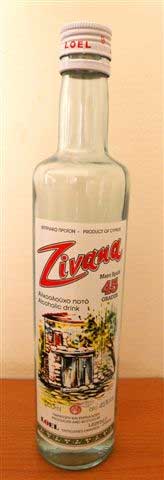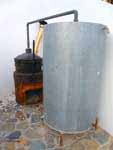.

Zivania. Photo : Augusta Stylianou Artist
Zivania (also Zivana) (Greek: Ζιβανία) is a traditional Cypriot beverage, a distillate produced in the island of Cyprus from pomace (or marcs), the residue of grapes that were pressed during the winemaking process (including the stems and seeds) mixed with high-quality dry wines produced from the local grape varieties of Cyprus. The pomace/wine mixture is then distilled in special traditional distillation apparatus, producing zivania. Zivania is characterized by its typical taste and aroma. It is colorless and it has a pleasant alcoholic with light aroma of raisins. The typical alcohol content is 45% by volume. It contains no sugars and has no acidity.
History
Zivania has been produced in Cyprus since the time the Republic of Venice ruled the island, around the end of the 14th century. Evidence of its continued production during the Ottoman and British occupation of the island comes from writers such as the British writer Samuel Baker who in 1879 reports: "...the refuse of skins and stalks is laid upon one side to ferment for the manufacture of raki, or spirit, by distillation...". [1] Since 2004, Zivania has been protected under EU regulations as a product unique to Cyprus and as such cannot be produced in any other country and marketed under that name [2].
Production

Distillation apparatus "kazani" for the production of Zivania
In order to produce zivania of the highest quality, mature healthy grapes of the best quality are used. The grape must to be used for the fermentation should be of less than 13° Baumé, in order to get perfect fermentation. As soon as the fermentation process is complete (i.e. less or equal to 0° Baumé reading) the wine and pomace are transferred to the main container of the distillation apparatus, kazani (Greek: καζάνι), and the distillation process begins. The last zivania coming out of the apparatus is called porakos (Greek: πόρακος) and it has a low alcohol content. There are mainly three types of distillation processes:
* Only wine is used for the distillation
* Wine and pomace are used for the distillation
* Pomace with water and weak zivania (porakos) are used
Depending on the distillation process, different qualities of zivania can be produced.
Storage and Transportation
Zivania is usually stored in clean wooden or galvanised metal containers that can be sealed in order to contain evaporation. During transportation good care is taken not to damage the containers or allowing leakage or evaporation of zivania.
Usage
Other than enjoying zivania as an alcoholic drink, it is used in Cyprus for several other purposes. It is used to treat wounds, for massaging sore body parts, as a remedy for colds, toothaches or as a warming-up drink during the cold months of winter, especially at villages on the Troodos mountains. In the old times, the main alcoholic drinks Cypriots consumed were wine and zivania. In some villages of Cyprus, cinnamon was added to zivania giving it a nice red color and a fine aroma and flavor. As zivania ages it becomes better and more aromatic. Aged zivania was valued very high and was kept for consumption during special occasions or as a treat for visitors. Even nowadays at some villages in Cyprus, visitors will be welcomed to a home with zivania served together with almonds, walnuts, loukoumi, soutzoukos or small appetizers like loukaniko (traditional Cypriot sausage), or lountza (traditional Cypriot smoked pork loin).
Authenticity
To establish the authenticity of zivania chemical studies were contacted to investigate which of the metals analyzed constitute diagnostic parameters that establish authenticity. The results of the studies establish that zivania is related to the unique geological and climatic conditions existing on the island of Cyprus. [3] [4]
Consumption
Zivania is served ice-cold with the local meze, soutzoukos or dried fruit and nuts.
See also
* Pomace brandy
Spirits similar to zivania are Greek tsipouro, Cretan tsikoudia (or raki), Balkan rakia, pisco and Italian grappa.
References
- ^ Samuel W. Baker (1879). Cyprus, as I Saw it in 1879. Project Gutenberg (Etext edition, 2003). p. 120. http://www.gutenberg.org/etext/3656.
- ^ EU declares zivania uniquely Cypriot, Cyprus Mail archive article - Thursday, October 26, 2006[1]
- ^ Authenticity of the Traditional Cypriot Spirit "Zivania" on the Basis of H NMR Spectroscopy Diagnostic Parameters and Statistical Analysis [2]
- ^ Authenticity of the traditional Cypriot spirit zivania[3]
| Ancient Greece
Science, Technology , Medicine , Warfare, , Biographies , Life , Cities/Places/Maps , Arts , Literature , Philosophy ,Olympics, Mythology , History , Images Medieval Greece / Byzantine Empire Science, Technology, Arts, , Warfare , Literature, Biographies, Icons, History Modern Greece Cities, Islands, Regions, Fauna/Flora ,Biographies , History , Warfare, Science/Technology, Literature, Music , Arts , Film/Actors , Sport , Fashion --- |
